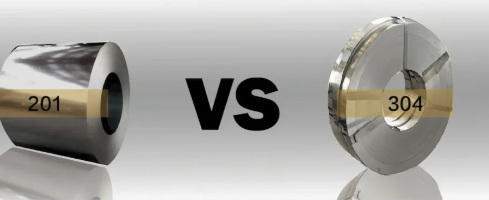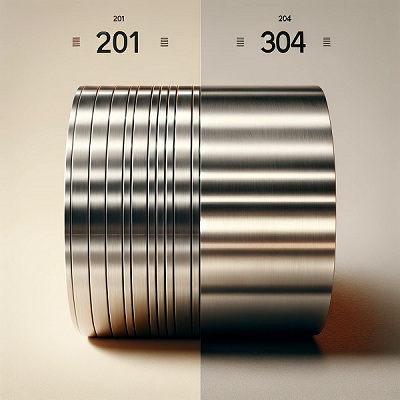English


Views: 222 Author: Tomorrow Publish Time: 2025-07-17 Origin: Site











Content Menu
● Chemical Composition Differences
● Corrosion Resistance and Durability
● Mechanical Properties and Workability
● Maintenance and Lifecycle Costs
● FAQ
>> 1. What are the main chemical differences between stainless steel 201 and 304?
>> 2. Which stainless steel grade is better for outdoor use?
>> 3. Is stainless steel 201 suitable for food processing equipment?
>> 4. How do the maintenance costs compare between the two grades?
>> 5. Can stainless steel 201 replace 304 in all applications?
Stainless steel is a critical material in numerous industries, from construction to kitchenware, valued for its durability and corrosion resistance. Among its various grades, 201 and 304 stainless steel are two of the most commonly used types, each with distinct characteristics that influence their cost and performance. This article presents a detailed comparison between stainless steel grades 201 and 304, focusing on their composition, corrosion resistance, mechanical properties, costs, maintenance requirements, and typical applications to help you make an informed decision.

The primary difference between grades 201 and 304 stainless steel lies in their chemical composition, which directly impacts their corrosion resistance and mechanical performance.
- Stainless Steel 201 contains approximately 16%-18% chromium, 1%-1.5% nickel, and a higher content of manganese and nitrogen. Its nickel content is significantly reduced compared to 304, making it a more economical option.
- Stainless Steel 304 has about 18%-20% chromium and 8%-10.5% nickel, which enhances its rust resistance and toughness. It has lower manganese compared to 201 and typically contains a bit more carbon, helping improve flexibility and strength.
Because 304 has more nickel and chromium, it forms a thicker and more durable passive oxide layer that protects it better in corrosive environments. Grade 201's higher manganese gives it increased hardness but makes it somewhat more prone to corrosion and less tough than 304.
The corrosion resistance of stainless steel is critical for applications exposed to moisture, chemicals, and environmental stress.
- Grade 304 is highly resistant to rust and oxidation due to its higher chromium and nickel content. It performs well in wet and salty environments, such as coastal areas or food processing operations. This higher corrosion resistance also means 304 stainless steel generally lasts longer, reducing the need for frequent replacements.
- Conversely, grade 201 offers moderate corrosion resistance suitable for dry or mildly corrosive environments, such as indoor settings with limited exposure to moisture. However, it is more susceptible to rust, especially if scratched or damaged, and requires regular maintenance to prevent corrosion.
The mechanical properties and ease of fabrication affect how each grade is used in manufacturing and construction.
- Grade 201 stainless steel is harder and more brittle due to its higher carbon content and manganese. It can be more easily scratched, and it tends to be less ductile than 304. However, it is more malleable for certain forming processes but may suffer in toughness and long-term structural integrity.
- Grade 304 offers better toughness and flexibility, making it suitable for products requiring high forming and welding quality. It is highly workable with excellent stainless steel finish qualities, preferred in applications where aesthetics and durability are priorities.
Cost is often a decisive factor when selecting between 201 and 304 stainless steel.
- Stainless Steel 201 is generally more affordable due to its reduced nickel content, which is the most expensive alloying element in stainless steel. Using 201 can yield cost savings of up to $1,000 per metric ton compared to 304, making 201 attractive for budget-sensitive projects.
- Stainless Steel 304 carries a higher upfront cost but offsets this with a longer lifespan and reduced maintenance expenses. The durability and corrosion resistance reduce the total lifecycle cost, especially in harsh environments where replacements and repairs for 201 would otherwise accumulate.

Maintenance expenses and lifecycle considerations can impact the overall budget and project success.
- Grade 201 requires more frequent maintenance, typically necessitating cleaning and rust prevention every 6 to 12 months. Repairs due to corrosion can cost $150 to $500 annually per 1,000 square feet, which can accumulate over time.
- Grade 304 generally needs less upkeep, thanks to its superior corrosion resistance. It can last 50% to 100% longer in moist or corrosive settings, reducing downtime and repair costs over its usable life.
Choosing grade 304 can therefore be more economical in differentially harsh or outdoor environments, whereas 201 remains cost-effective in controlled, indoor projects.
Knowing where each stainless steel grade excels can clarify which to use.
- Stainless Steel 201 is often selected for indoor applications such as kitchen appliances, industrial furniture, decorative elements, and light structural components where cost is more constrained and exposure to severe corrosion is limited.
- Stainless Steel 304 is preferred for applications requiring high corrosion resistance and lasting durability such as food processing equipment, sanitary fixtures, medical devices, marine applications, and more demanding architectural projects.
Choosing between stainless steel grades 201 and 304 depends on balancing cost with desired durability and performance. Grade 201 offers a cost-effective option for projects with budget constraints and limited exposure to corrosive environments, making it suitable for indoor or light-duty use. However, it demands more frequent maintenance and has a shorter lifespan. On the other hand, grade 304, while more expensive upfront due to higher nickel and chromium content, delivers superior corrosion resistance, toughness, and longevity, ultimately reducing lifecycle costs and repair needs, which can justify its premium price in harsh or outdoor environments. Assessing your specific application, environmental exposure, and budget will guide the best choice between these two widely used stainless steel grades.

Grade 201 has lower nickel (1%-1.5%) and higher manganese, while 304 contains higher nickel (8%-10.5%) and chromium (18%-20%), resulting in better corrosion resistance and toughness in 304.
Grade 304 is better suited for outdoor or corrosive environments due to its higher corrosion resistance and longer lifespan, making it more durable under harsh weather conditions.
Generally, grade 304 is recommended for food processing because of its superior corrosion resistance and hygiene properties. Grade 201 can be used in less demanding environments but is not the first choice for food-grade applications.
Grade 201 requires more frequent maintenance and rust prevention, costing potentially hundreds in upkeep yearly per square meter, while 304 needs less maintenance, thereby lowering long-term expenses.
No, 201 can substitute 304 only in applications where budget limits and environmental conditions are favorable. It is less corrosion-resistant and more brittle, so it is not suitable for demanding or harsh environments.
Stainless Steel Grades 201 Vs 304: Cost Vs Performance Breakdown
316L Vs 316 Stainless Steel Grades: Which Is Better for Corrosion Resistance?
Comparing Austenitic Vs Martensitic Stainless Steel Grades: What You Need To Know?
Stainless Steel 430 Vs 304: Key Differences Explained for Manufacturers
304 Vs 316 Stainless Steel Grades: Which One Suits Your Project Best?
Stainless Steel Pipes Vs Galvanized Pipes: Durability And Cost Analysis
Comparing Stainless Steel Pipes And PVC Pipes: What You Need To Know?
Stainless Steel Pipes Vs Copper Pipes: Pros And Cons for Industrial Use
Seamless Stainless Steel Pipes Vs Welded Pipes: Key Differences Explained
Stainless Steel Pipes Vs Carbon Steel Pipes: Which One Suits Your Project?
